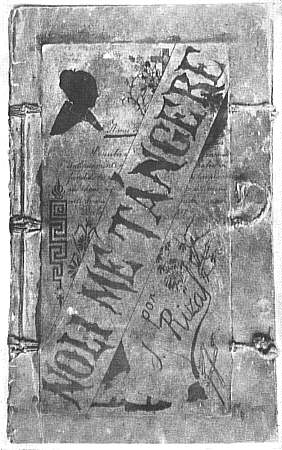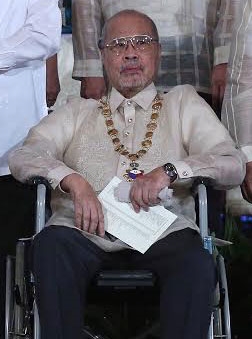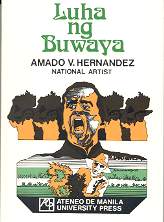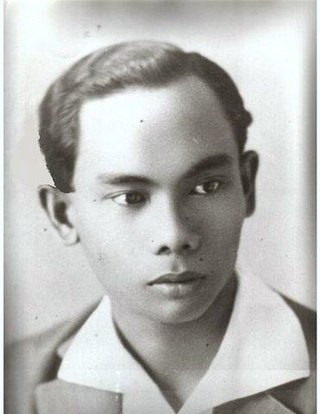Related Research Articles

The Katipunan, officially known as the Kataastaasang , Kagalanggalangang Katipunan ng mga Anak ng Bayan or Kataastaasan Kagalang-galang na Katipunan ng mga Anak ng Bayan, was a Philippine revolutionary society founded by anti-Spanish colonialist Filipinos in Manila in 1892; its primary goal was to gain independence from Spain through a revolution.

Noli Me Tángere by Filipino writer and activist José Rizal published during the Spanish colonial period of the Philippines. It explores perceived inequities in law and practice in terms of the treatment by the ruling government and the Spanish Catholic friars of the resident peoples in the late nineteenth century.

Amado Vera Hernandez, commonly known as Amado V. Hernandez, was a Filipino writer and labor leader who was known for his criticism of social injustices in the Philippines and was later imprisoned for his involvement in the communist movement. He was the central figure in a landmark legal case that took 13 years to settle.

Cirilo F. Bautista was a Filipino poet, critic and writer of nonfiction. A National Artist of the Philippines award was conferred on him in 2014.
Epifanio San Juan Jr., also known as E. San Juan Jr., is a known Filipino American literary academic, Tagalog writer, Filipino poet, civic intellectual, activist, writer, essayist, video/film maker, editor, and poet whose works related to the Filipino Diaspora in English and Filipino writings have been translated into German, Russian, French, Italian, and Chinese. As an author of books on race and cultural studies, he was a "major influence on the academic world". He was the director of the Philippines Cultural Studies Center in Storrs, Connecticut in the United States. In 1999, San Juan received the Centennial Award for Achievement in Literature from the Cultural Center of the Philippines because of his contributions to Filipino and Filipino American Studies.

Luha ng Buwaya or, "Crocodile's Tear" in translation, is a novel written by Palanca Awardee and Filipino novelist Amado V. Hernandez. It consists of 53 chapters. The story is about poor farmers uniting against the greedy desires of the prominent family of the Grandes. In Filipino idioms, "crocodiles" were used to symbolize those people who are corrupt. The "buwaya" (crocodile) in the title refers to the Grandes family, who were greedy for money.

Lope K. Santos was a Filipino Tagalog-language writer and former senator of the Philippines. He is best known for his 1906 socialist novel, Banaag at Sikat and to his contributions for the development of Filipino grammar and Tagalog orthography.

Matanglawin, literally "Hawk's Eye" and usually contracted as Mata, is the official student publication of the Ateneo de Manila University in the Filipino language. The student paper dedicates itself to discussing socio-political issues in the Philippines, the plight and suffering of the working class, as well as pressing student rights issues. It is part of the Ateneo's Confederation of Publications (COP), including The GUIDON and Heights.
María Odulio de Guzmán was a Filipino teacher, educator, principal, writer, and author.

The Propaganda Movement encompassed the activities of a group of Filipinos who called for political reforms in their land in the late 19th century, and produced books, leaflets, and newspaper articles to educate others about their goals and issues they were trying to solve. They were active approximately from 1880 to 1898, and especially between 1880 and 1895, before the Philippine Revolution began.
Makamisa is an unfinished novel written by Filipino patriot and writer José Rizal. The original manuscript was found by historian Ambeth Ocampo in 1987 while going through a 245-page collection of papers. This draft is written in pure, vernacular Lagueño Tagalog and has no written direct signature or date of inscription.

Alberto Segismundo Cruz was a Filipino poet, short story writer and novelist. Three of his novels have been published by Ateneo de Manila Press.

José Protasio Rizal Mercado y Alonso Realonda was a Filipino nationalist, writer and polymath active at the end of the Spanish colonial period of the Philippines. He is considered the national hero of the Philippines. An ophthalmologist by profession, Rizal became a writer and a key member of the Filipino Propaganda Movement, which advocated political reforms for the colony under Spain.
Patricio Mariano y Geronimo was a Filipino nationalist, revolutionary, pundit, poet, playwright, dramatist, short story writer, novelist, journalist, violinist, and painter. Mariano was a Katipunan member. Mariano was the son of Petronilo Mariano and Dionisia Geronimo.

José Cándido Alejandrino y Magdangal was a Philippine Republican Army general during the Philippine Revolution and the Philippine–American War.
Tomas "Tommy" Abuel is an actor and lawyer from the Philippines. He won the FAMAS Best Supporting Actor Award in Maynila, Sa Kuko Ng Liwanag (1975), and Karma (1981); and Cinemalaya Best Actor Award in ;;Dagsin (2016).

Mga kababayang dalaga ng Malolos, also known by its alternative English title To the young women of Malolos, is a letter written by Filipino author and political reformer José Rizal on February 22, 1889. It is written in Tagalog and is addressed to a group of women from Malolos, Bulacan who successfully lobbied the Spanish colonial government to allow them to open a school so that they could study the Spanish language.
Ramon Guillermo is a Filipino novelist, translator, poet, activist, and academic in the field of Southeast Asian Studies.
Anarchism in the Philippines has its roots in the anti-colonial struggle against the Spanish Empire, becoming influential in the Philippine Revolution and the country's early trade unionist movement. After being supplanted by Marxism-Leninism as the leading revolutionary tendency during the mid-20th century, it experienced a resurgence as part of the punk subculture, following the fragmentation of the Communist Party of the Philippines.
Gelacio Y. Guillermo Jr. was a Filipino poet, critic, translator, essayist, and revolutionary.
References
- 1 2 "Mga Ibong Mandaragit" by Amado V. Hernandez, from Amado V. Hernandez: An Introduction, Appreciating Amado V. Hernandez, Revolutionary Proletarian Artist, philcsc.wordpress.com, August 28, 2006
- 1 2 Hernandez, Amado V. Mga Ibong Mandaragit: Nobelang Sosyo-Politikal, with a Prologue by Carlos P. Romulo and Epilogue by Epifanio San Juan, Jr., Progressive Printing Palace, Quezon City, 1969, 416 pages.
- ↑ Veric, Charlie Samuya. "Mga Ibong Mandaragit" by Amado V. Hernandez Archived June 14, 2011, at the Wayback Machine , The Fictions of Necessity, Book Review of Caroline Hau’s “Necessary Fictions”, Ateneo de Manila University, ateneo.edu
- ↑ "Penguin releases English version of 'Ibong Mandaragit'". ABS-CBN news.